Louis Vuitton
![]()
This article is about the luxury goods company. For the founder of the company, see Louis Vuitton (entrepreneur).
Louis Vuitton Malletier SAS is a French luxury goods company based in Paris that became famous for its exclusive suitcases and luggage. It was founded in 1854 by French craftsman and entrepreneur Louis Vuitton.
The main business of the now globally active company today still consists of high-priced luggage series as well as leather goods such as handbags and accessories, which are internationally regarded as a status symbol. Under the brand name Louis Vuitton, high-priced clothing for men and women, shoes, jewelry, watches and perfume are also offered through an international network of own boutiques and occasionally through upscale retailers. Many Louis Vuitton products are adorned with the monogram pattern made from the initials of the company's founder, "LV", which was introduced in 1896 and was originally intended to protect against brand piracy, but over the years has spawned a worldwide counterfeiting industry. Since its merger with the spirits manufacturer Moët Hennessy in 1987, the Louis Vuitton company has belonged to the luxury goods group LVMH Moët Hennessy - Louis Vuitton S.A., which was created from the merger and has since bundled other luxury brands from various sectors of the economy.
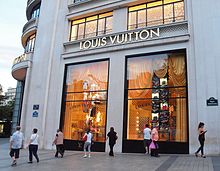
Louis Vuitton boutique in Paris

Shop window of the flagship store on the Champs-Élysées in Paris
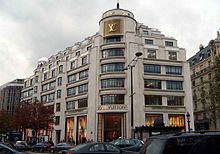
Louis Vuitton flagship store on the Avenue des Champs-Élysées in Paris
Brand in the LVMH Group
Louis Vuitton is today one of the main brands of the LVMH Group and is managed together with other brands such as Fendi, Kenzo, Givenchy, Loewe and Marc Jacobs in the Fashion & Leather Goods division. As of 2012, the Fashion & Leather Goods division operated a total of approximately 1250 stores worldwide for its individual brands, of which the Louis Vuitton brand accounted for over 450, and generated total sales of €8.712 billion with profits of €3.075 billion in 2011. LVMH does not provide details on the sales and profits of the individual brands. It is estimated that the Louis Vuitton brand generates about 25 percent of the LVMH Group's total sales (all business units: 23.66 billion euros in fiscal 2011), while accounting for 60 to 70 percent of the group's profit (5.26 billion euros in 2011).
In mid-2012, the estimated enterprise value of the LVMH Group, including its main brand Louis Vuitton, was €66.38 billion. As early as 2009, the company was rated as the "most valuable brand" among international luxury goods manufacturers in a global ranking comparison, placing it among the top 20 of all the world's most important brands.
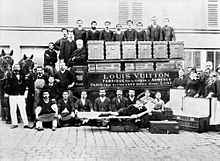
Vuitton family with staff in Asnières, 1888
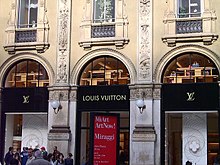
Louis Vuitton boutique in Milan's Galleria Vittorio Emanuele, 2008
History
The years 1854-1892: Louis Vuitton
After Louis Vuitton had been apprenticed to a Parisian suitcase and luggage manufacturer and had worked there for a total of 17 years, he opened his own shop, Louis Vuitton Malletier, at the age of 33 in Paris in 1854 at 4 rue Neuve-des-Capucines, today's rue des Capucines, not far from the Place Vendôme. There he sold, among other things, high-priced, flat suitcases that were very light and airtight by the standards of the time, and well suited for travel in then-modern modes of transportation such as rail or ship. The French word malletier, which Vuitton included in the company name, means suitcase manufacturer.
Louis Vuitton built a factory in the Parisian suburb of Asnières in 1859 and had 20 employees there manufacture modern suitcases made of coated, water-repellent and hard-wearing material. The frames of the suitcases consisted of a wood and metal construction. Vuitton used linen fabric impregnated with rye flour as the surface material for its luggage. This material, initially called Trianon and still grey in colour, proved to be dust and water resistant. The Trianon covering was later joined by a linen outer fabric in a longitudinally striped rayée pattern. At the turn of the century, about 100 employees worked for Louis Vuitton in Asnières; by 1914, the workforce had grown to 225. The manufacturing facility in Asnières continues to this day with approximately 150 employees and is used to produce the highest quality items in the Louis Vuitton range. As of 2009, there were a total of 17 Louis Vuitton production facilities worldwide.
In 1867, Louis Vuitton participated in the Exposition Universelle de Paris, the World's Fair in Paris. In 1885, Vuitton opened his first store outside of France. The ever-increasing popularity of the suitcase manufacturer led him to Oxford Street in London. In 1886, Vuitton and his son Georges Vuitton (1857-1936) developed a patented suitcase lock, innovative for its time, the design of which is still used today. In 1888, Vuitton introduced the checkerboard Damier pattern on his waterproof linen fabric, which can still be found in collections today. He died in 1892.
The years 1893-1936: Georges Vuitton
After Louis Vuitton's death, his son Georges took over the company. He presented the products at the Chicago World's Fair in 1893. In the meantime, the product range had grown to include large-format and folding wardrobe trunks, multifunctional and convertible suitcases for expeditions, cabin trunks for ship passengers, suitcase-like hat boxes and suitcases with removable interior compartments. For special customers such as the explorer Pierre Savorgnan de Brazza, a suitcase that can be converted into a bed was developed.
In 1896 Georges Vuitton created the world-famous LV signet, printed on the tried-and-tested linen fabric. The pattern had been developed to protect against the increasing imitation of Louis Vuitton's case design by competitors. The use of stylized flowers in this so-called toile monogram or monogram canvas pattern was based on the trend at the time to use Japanese and oriental designs, borrowing from Art Nouveau. That same year, Vuitton began a tour of the United States, visiting major cities such as New York, Chicago and Philadelphia to sell his wares.
In 1901, he invented the Steamer Bag, a rectangular travel bag with a fold-over closure and handles that could easily be placed inside a larger one. The bag became a best seller. In 1914, Georges Vuitton opened the largest travel goods store on the Avenue des Champs-Élysées in Paris. When World War I began, stores were opened in New York, Bombay, Washington, London, Alexandria and Buenos Aires. In subsequent years, other large leather or canvas travel bags were added to the portfolio, including the Keepall travel bag (originally called the Tientout) in 1930. In 1932, Louis Vuitton launched another bag, the Noé model, which became a box office hit. The bag, in the form of a handy sack with a drawstring closure and shoulder strap, was originally designed to carry exactly five bottles of champagne. It was the first true women's handbag from the house of Louis Vuitton. A short time later, the world-famous Speedy handbag was launched, which is similar in shape to a cosmetics case with two handles that is still in use today. A special production of this time was, for example, a travel case that could be converted into a secretary for the conductor Leopold Stokowski.
In 1936 Georges Vuitton died. His son Gaston-Louis Vuitton (1883-1970) took over the company.
The years 1936-1986: Gaston-Louis Vuitton
To expand the range, the company worked on the monogram canvas pattern in 1959 to use it for purses, wallets and handbags. The original linen fabric was replaced by a resistant cotton fabric (toile/canvas) soaked in polyvinyl chloride. In 1966, the Louis Vuitton company celebrated the introduction of a cylindrical handbag in landscape format with long handles, called Papillon, which is still in great demand today.
From the late middle of the 20th century, the demand in Europe for large overseas suitcases declined. For car journeys and air travel, even lighter suitcases that were as indestructible as possible, preferably made of plastic, were now desired. Consequently, the demand for high-priced Louis Vuitton suitcases declined. In the mid-1970s, the Louis Vuitton company employed 60 people and operated only two boutiques, in Paris and Nice.
After the death of Gaston-Louis Vuitton in 1970, his grandson, Patrick-Louis Vuitton (b. 1951), joined the company in 1971, where he is still in charge of the custom-made department for special customer requests, of which about 350 are fulfilled every year. In 1977, at the request of the family, Henry Racamier (1912-2003), husband of Odile Vuitton, daughter of Gaston-Louis Vuitton, took over the management of the company at the age of 65 and grew it considerably through numerous initiatives over the following decade. Racamier is credited with the transition of the Louis Vuitton brand from the luxury niche market to the luxury mass market. In 1978, under Racamier's leadership, Louis Vuitton entered the Asian market, opening stores in Tokyo and Osaka, Japan; a few years later, in 1985, in Seoul, Korea. Until 1977, production had been exclusively in Asnières, after which additional manufacturing facilities were opened under Racamier to meet growing demand. In 1983, Louis Vuitton S.A. became involved in sports finance for the first time in a promotional manner, supporting the America's Cup sailing regatta by introducing a preliminary round selection known as the Louis Vuitton Cup. In 1984, Louis Vuitton went public in Paris to generate capital. In 1986, funds from the IPO were used to buy out champagne maker Veuve Clicquot, perfume maker Givenchy, and a stake in cosmetics company Guerlain. Group sales at the time were 3.7 billion francs with a profit of around 400 million francs.
In 1987, to protect against a hostile takeover, Louis Vuitton S.A. merged with the French spirits producer Moët Hennessy, which itself had been created in 1971 from a merger between the champagne producer Moët & Chandon and the brandy producer Hennessy. The result was the LVMH Moët Hennessy - Louis Vuitton S.A. group. in which numerous well-known brand names were bundled over the years, including the Louis Vuitton brand. However, even the merged company was unable to defend itself against the dreaded hostile takeover, which was ultimately successfully carried out by the French entrepreneur Bernard Arnault, who became Chairman of the Board of LVMH in 1989. Racamier himself had brought Arnault into the company as an investor in 1988, who ultimately opposed Racamier in the battle for power in the company and forced him out of the company in 1990 after massive share purchases. By the end of the 1980s, there were about 130 Louis Vuitton boutiques worldwide. Sales in Asia accounted for 40 percent of total sales at the time.
The years 1987-today: LVMH
In 1990, Frenchman Yves Carcelle (1948-2014), who had worked for LVMH since 1989, became CEO of Louis Vuitton. Two years later, the first store in China was opened, at the Peninsula Palace Hotel in Beijing. During this time, the two types of leather Epi and Taiga were developed - there is a wide range of products of both types today.
In the mid-1990s, the former home of the Vuitton family in Asnières was transformed into a company museum. At that time, there were around 200 Louis Vuitton stores worldwide.
In 1997, US fashion designer Marc Jacobs was engaged to launch Louis Vuitton's first clothing line for men and women in March of the following year. The collections have been presented twice a year at the Paris fashion shows ever since. Jacobs was creative director at Louis Vuitton until the end of 2013 and thus not only determined the designs of the house's fashion collections, but also had a decisive influence on the design of the rest of the Louis Vuitton product range.
In 2000, the first store on the African continent was opened in Marrakech, Morocco. In 2001, US artist and fashion designer Stephen Sprouse (1953-2004) collaborated with Marc Jacobs to design a limited edition of handbags, such as the Speedy or the Keepall, with graffiti-style Louis Vuitton lettering. This limited edition was reserved for celebrities on the company's internal client list. In addition, Marc Jacobs created Louis Vuitton's first piece of jewelry in 2001 with the high-priced charm bracelet, which has since appeared in many variations. In 2003, Japanese artist Takashi Murakami collaborated with Marc Jacobs to create a multicolored line featuring a colorful Monogram pattern on white and black bags and various accessories. Murakami also created the Cherry Blossom pattern with depictions of cherry blossoms in 2002 and the Cherry pattern with cherry illustrations on bags and accessories in a limited edition in 2005.
In late 2005, Dutchman Paul Helbers, a former designer at Martin Margiela, was appointed studio director for the menswear collection at Louis Vuitton. From 2008 he also appeared with creative director Marc Jacobs at the end of the menswear shows for the traditional bow on the catwalk. British fashion designer and former Dunhill designer Kim Jones was named Helbers' successor in March 2011, appearing alone at the end of the fashion shows.
In 2008, Japanese designer Rei Kawakubo created an exclusive canvas bag collection for Louis Vuitton. In 2009 there was a revival of the 2001 collection by Stephen Sprouse, the bags with monograms got more color with bright graffiti prints in pink, green and orange. Furthermore, there was a collection with rose print. In 2009, all external repair shops in Europe were dissolved and the Louis Vuitton repair shop in Cergy (France) was expanded. <Source?> Since the beginning of 2010, selected Louis Vuitton products are also offered as customized mass production. This gives customers the opportunity to order custom bags and cases with their own initials and colors. In 2011, the Neverfull handbag in the form of a beach bag was added to the Louis Vuitton range. 2012 saw a collaboration with Japanese artist Yayoi Kusama via Marc Jacobs, who designed a women's collection for Louis Vuitton with her signature polka dot pattern on leather goods, suitcases, prêt-à-porter fashion, scarves, sunglasses and jewellery.
At the end of 2012, after 22 years at the helm of Louis Vuitton, Yves Carcelle was replaced as CEO by Spaniard Jordi Constans, a former Danone executive. Constans had to leave his post after barely three weeks in the role for health reasons. Since then, LVMH executive Michael Burke - previously CEO of Louis Vuitton USA, Fendi and Bulgari in succession - has led Louis Vuitton. In November 2013, Louis Vuitton announced that Marc Jacobs would leave the company at the end of the year and be replaced by former Balenciaga designer Nicolas Ghesquière as creative director of the women's collections.
Kim Jones moved to Dior Homme in January 2018. Louis Vuitton announced at the end of March 2018 that American Virgil Abloh, founder of his own streetwear fashion brand Off-White and long-time business partner of Kanye West, would succeed Jones.
In 2017, the British newspaper The Guardian found out that Louis Vuitton has its shoes produced by the LVMH subsidiary Somarest in Cisnădie (Romania). Materials are shipped to Romania where they are processed into shoes at a low cost. The shoes are then shipped to Italy and soled there. Therefore, the designation of origin Made in Italy ('made in Italy') may be affixed.
Product logo
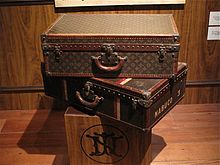
Historic Louis Vuitton Suitcases
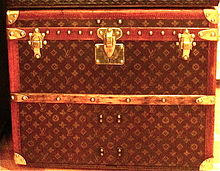
Overseas suitcase in classic monogram canvas pattern
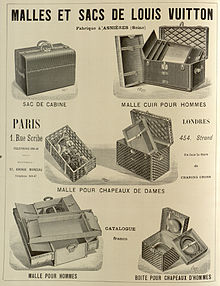
Advertisement for suitcase, 1898

Company founder Louis Vuitton, ca. 1870s
Questions and Answers
Q: When was Louis Vuitton founded?
A: Louis Vuitton was founded in 1854.
Q: What types of products does Louis Vuitton sell?
A: Louis Vuitton sells shoes, watches, jewellery, accessories, sunglasses and books.
Q: How are Louis Vuitton products made?
A: Louis Vuitton products are still made by hand.
Q: What did Louis Vuitton do to protect his designs?
A: Louis Vuitton changed the Trianon design to a beige and brown in 1876 to protect the duplication of his look.
Q: Where did Louis Vuitton open its first store in England?
A: Louis Vuitton opened its first store in London, England on Oxford Street.
Q: When did Louis Vuitton start producing purses, bags and wallets?
A: Louis Vuitton started producing purses, bags and wallets in 1959.
Q: What was the annual income of Louis Vuitton in 1977?
A: The annual income of Louis Vuitton in 1977 was 70 million francs.
Search within the encyclopedia